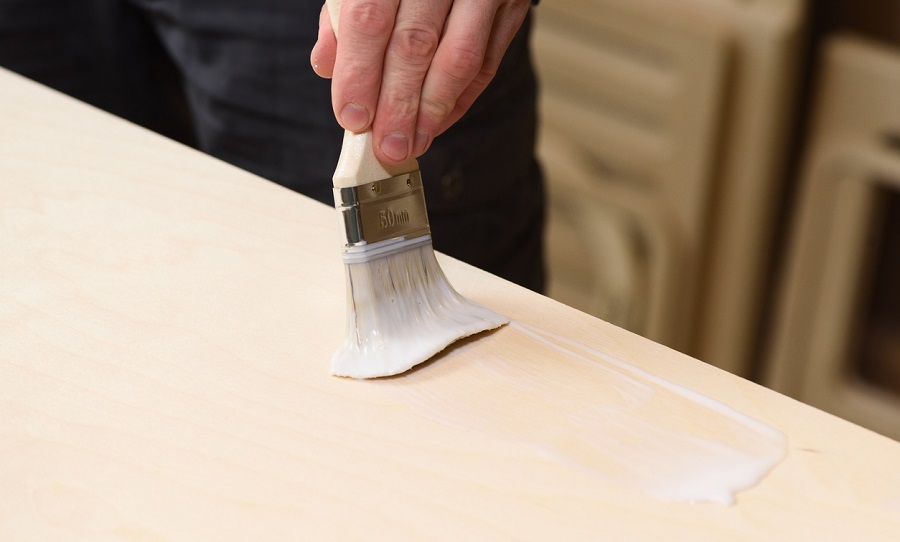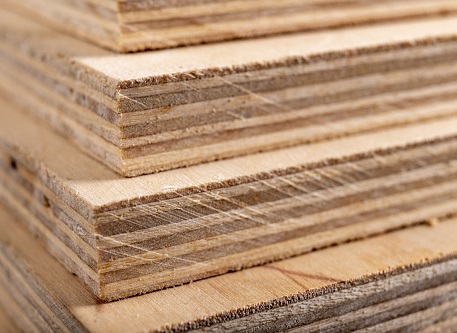Sealing & Waterproofing Plywood: What You Should Know
Reading time: 12 minutes
Do you need to seal exterior plywood?
Plywood needs to be sealed before using it outdoors, or in high moisture areas such as bathrooms and kitchens. This is because plywood is not waterproof or rot resistant, and it is at risk of warping, splitting or degrading over time. Sealing plywood also makes it stronger, and using a waterproof paint can give it an attractive finish.
Engineered plywood is strong yet lightweight, compared to many other sheet materials, and by sealing it it’s possible to use it both indoors or outside. As well as being a popular material for first fix structural work in construction, it is also ideal for outdoor furniture and landscaping projects.
If you don’t seal plywood before using it outdoors, the following problems can occur:
Plywood can peel apart
The layered structure can start to come apart if the plywood isn’t properly sealed, when moisture starts to get in. Even if you buy pressure treated plywood, which is designed to be a preservative treatment to give the wood moisture resistance and strength, the edges and inner layers may not be as moisture resistant, causing the plies to swell and split.
Plywood can warp
As mentioned, when water gets into the plywood layers it can cause the wood to warp. As well as looking unattractive, it can render the structure useless. Treating the wood and sealing plywood edges helps to prevent this.
Weathering can cause rot
If plywood is used outside, rot can set in if it’s not sealed and maintained. Nail and screw points are particularly at risk. UV light and heavy rain can also degrade the surface and natural colour of the wood. Dry rot can also be a risk indoors, too.
It is at risk of fungus
When exposed to moisture for a long time, fungus and mould can grow if the plywood isn’t properly sealed. As well as looking unsightly, it can become a health risk to homeowners.
Benefits of waterproofing plywood
It is simple to waterproof and seal plywood, as it’s a porous wood with a smooth finish that easily bonds with paint, oil or other sealing materials. As well as making the wood strong and durable, waterproofing plywood offers many advantages:
Prevents rot
By sealing plywood edges and faces, you can prevent water from getting into the wood by waterproofing it. Plywood is not naturally moisture resistant so it absorbs water easily. Sealing prevents rot and having to replace the wood regularly from dry rot or wet rot.
Prevents splitting and warping
By waterproofing the wood for exterior use, or for use in bathrooms and kitchens, the wood is less likely to take on moisture which causes it to expand, split and warp. This severely reduces its strength and structural integrity.
Prevents damage from weathering
As well as sealing the wood to give it a great finish, this helps it to stand up to rain, wind, sun damage and extreme temperatures outdoors. This helps it to last longer and stay strong.
The obvious benefits of sealing plywood for outdoor use and for bathrooms and kitchens are to protect the wood from moisture, but it’s also worth sealing the wood for other areas of the home too. If a leak happens, it can damage and warp the wood. Simply use a waterproofing epoxy, oil, paint, vanish, PVA or liquid latex. A properly sealed plywood could last up to 40 years.
What to use for sealing plywood
If you’re wondering how to seal plywood, you can buy different products for different uses. A simpler way to seal plywood is to use an oil, whilst a heavy duty waterproofing latex solution may be needed for prolonged outdoor use. Here are some of the products to consider for your project:
Drying oil
Drying oil is a light sealant which lets the wood keep its natural look and feel. The oil soaks into the layers to form a thin natural barrier which protects the wood. Although it doesn’t form a 100% waterproof layer, it helps strengthen the wood and prevent it from being damaged by moisture. Drying oil is ideal for deck fittings, work surfaces and marine use.
Epoxy
Epoxy sealers are usually the preferred method of sealing and waterproofing plywood. Epoxy doubles as an adhesive, which gives an additional layer of strength plus protection for the wood, helping it to last even longer. It can double as a primer too, if the wood is to be painted after sealing. Epoxy sealants can be used anywhere indoors or outdoors, and are perfect for exterior structures, such as out buildings, which are prone to outdoor weathering damage.
Waterproof paint
Water-Based Paint, specifically designed for outdoor use, is a great way to seal and waterproof your plywood, whilst giving it an attractive colour. It may need to be sanded and touched up over the years, but it’s a long lasting solution for indoors or outdoors. Paint sealants are ideal for sheds and landscaping work.
Varnish
Varnishing plywood is a great way to waterproof the face and seal edges of plywood. It gives a hard, fully moisture resistant coating which has a shiny finish. Exterior wood varnishes are usually designed to expand and contract in different weather conditions, to reduce peeling and cracking. Varnish is suitable for boats, decking and furniture.
PVA
PVA glue (polyvinyl acetate) has a wide range of uses, as well as being an easy to use wood glue, it makes it a good-value waterproofing option for plywood. It’s easy to apply and dries clear, giving a smooth finish. Usually, you would dilute specialist wood PVA with water before applying. PVA glue can safely be used for waterproofing plywood, or as a primer before painting. As it has no toxic fumes and is safe to use around the home, PVA is a great way to seal internal plywood structures such as shelves and wood panelling.
Liquid latex
Liquid Latex comes in both a wood stain liquid form, or a spray, making it fast and easy to apply. It can be more costly, but bonds well to plywood and can be used to seal both interior wood in bathrooms, through to very hard-wearing exterior wood such as decking, boats and shed structures.
If you’re unsure which product to choose for your intended use, be certain to read the label first.
How to waterproof plywood
To waterproof plywood, an epoxy, waterproof paint, oil, varnish, latex or PVA can seal the wood for both indoor and outdoor use. These can come in either a paint-on or spray form, and they all bond easily to the wood to seal it and protect it from moisture. Simply sand down, apply and leave to dry.
How to seal plywood: tools required
Before waterproofing plywood, you’ll need:
-
Workbench and appropriate PPE (gloves, mask and eye protection)
-
Sandpaper (fine to medium grit) and/or sanding tool
-
Cloth (to wipe down surfaces after sanding)
-
Sealing/waterproofing product
1. Prepare your plywood
Firstly, make sure the plywood is clean and dry. Sand the surface and edges of the plywood. You can use traditional sandpaper or an electric sander, but it’s recommended to manually go over the edges to make sure all the crevices are sanded properly. It’s important to then wipe down the surfaces to remove dust and debris.

2. Apply wood sealer
Apply your chosen sealer as directed on the label. This may come in a spray format, or a paint-on liquid, in which case you can use a brush or roller. It’s important to cover the face of the wood as well as sealing plywood edges. Apply evenly and work into any holes or cracks.

3. Leave to dry before adding additional coats
Your chosen product should guide you as to how many coats you’ll need. This is usually a minimum of two. Make sure you take time to seal edges of plywood, as this is commonly where water can get in and start to warp the layers. Depending on its use, you do not necessarily need to coat both sides of the plywood, especially if only the front is exposed. You may wish to paint the wood after the waterproofing has dried.
How to seal plywood edges
Sealing plywood edges can be tricky if the wood is uneven. Make sure it’s sanded properly before applying the waterproofing seal. It’s best to use a brush or spray for edges, to get into crevices and fine cracks, to stop damp from getting in. It’s also possible to seal plywood edges using sealing pastes and tapes which are specifically designed for the job.
Waterproofing plywood: FAQs
What is the best way to waterproof plywood edges?
Plywood faces and edges need to be sealed to prevent water getting in and damaging the wood. Sealing the wood using a waterproofing epoxy, varnish, paint or oil can help keep it strong and looking its best. These can be applied after sanding using a spray, roller or brush.
How do you seal untreated plywood?
To waterproof plywood, an epoxy, waterproof paint, oil, varnish, latex or PVA can seal the wood for both indoor and outdoor use. These can come in either a paint-on or spray form, and they all bond easily to the wood to seal it and protect it from moisture. Simply sand down, apply and leave to dry.
Do I need to seal plywood after painting?
Plywood does not need sealing after painting. By painting the wood using a specially designed wood paint or varnish, you’re effectively sealing it and protecting it from moisture. To waterproof the wood, you may need to apply a sealing product, primer or waterproofing undercoat before painting with weatherproof paint.
Should you seal both sides of plywood?
Depending on its use, you do not necessarily need to seal both sides of the plywood, especially if only the front is exposed. This can save time and money. Of course, if you’re building a structure where all sides are exposed to the elements then all surfaces must be sealed.
Can I seal plywood with PVA?
PVA glue can safely be used for waterproofing plywood, or as a primer before painting. As it has no toxic fumes and is safe to use around the home, PVA is a great way to seal internal plywood structures such as shelves and wood panelling.
Can you use emulsion on plywood?
Emulsion paint isn’t designed for wood use, so it may not adhere well or be long lasting. Ideally, you should use a paint specifically designed for wood, with a primer or wood seal product underneath. Sand the wood first, wipe down and seal it before painting.
How do you seal plywood for indoor use?
The obvious benefits of sealing plywood for outdoor use and for bathrooms and kitchens are to protect the wood from moisture, but it’s also worth sealing the wood for other areas of the home too. If a leak happens, it can damage and warp the wood. Simply use a waterproofing epoxy, oil, paint, vanish, PVA or liquid latex.
Disclaimer: The information contained on this page is intended as an overall introduction and is not intended as specific advice from a qualified professional. Travis Perkins aims to avoid, but accepts no liability, in the case that any information stated is out of date.




